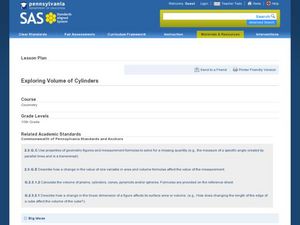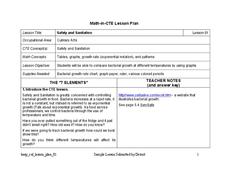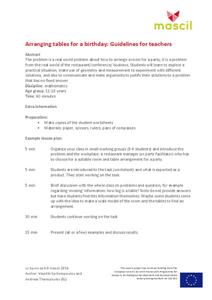Curated OER
Draw To Scale The E-Z Way
Fourth graders draw a rough floor plan of a house to scale without using a ruler to determine measurements. They see how architects use scale to draw blueprints, and solve math problems using scale.
Curated OER
Dot's Dot
In this math estimation worksheet, students estimate how many centimeters it is from each dot in a dot to dot puzzle. Students then use a ruler to measure exactly.
Curated OER
Exploring Volume of Cylinders
Tenth graders investigate the volume of a cylinder. In this geometry instructional activity, 10th graders create three-dimensional cylinders and use a ruler to determine the dimensions. The instructional activity progresses...
Curated OER
Vertical Angles Exploration
In this vertical angles explorations worksheet, 10th graders solve and complete 6 different types of problems. First, they use a ruler and a protractor to measure the angles illustrated. Then, students complete the tables next to each...
Curated OER
Congruent Coloring
In this mathematics worksheet, 1st graders find the pairs of polygons that are congruent on the sheet. Then they color them the same color and use their ruler to check their selections.
Curated OER
Line Segments and Dimensions
Fifth graders explore measurement. In this measurement lesson, 5th graders review fractions, simplifying and using rulers to practice measuring by inches and centimeters. Students are shown how to measure and given a...
Curated OER
Makeshift Measuring Tools
Fifth graders practice measuring items with unique tools. In this length lesson, 5th graders examine several household items and must decide if they want to use a pencil width, piece of paper, or their thumb to measure the item....
Curated OER
Paul Bunyan - A Folktale Full of Math
Sixth graders solve math problems from a folktale story. In this solving math problems from a folktale story lesson, 6th graders read the Paul Bunyan folktale. Students determine today's cost of the meals that Paul Bunyan...
Curated OER
Around We Go!
Young scholars make accurate measurements and calculations of measuring the area an perimeter of a section of the floor accordingly. They use appropriate measurement and calculation strategies to write a complete a clear explanation for...
Curated OER
Slopes for the Mathematically Inclined
In this slope worksheet, 9th graders solve and complete 6 different problems that include completing charts and applying applications to the real world. First, they use the pictures shown to measure the riser and tread of 3 consecutive...
Curated OER
Finding Area and Perimeter in a Miniature House Using Standardized Units
Young scholars explore the concept of area and perimeter. In this area and perimeter lesson, students construct miniature houses. Young scholars determine the area and perimeter of their model in order to buy glue, carpet, and wall paper.
Curated OER
Measuring Mixed Numbers
Mixed numbers can be added conceptually, algorithmically, and physically. Have the class visualize mixed numbers by adding fraction bars together. They then discover the algorithmic process that simplifies adding mixed numbers. Finally,...
Curated OER
Shapes and Tools
Young learners view different shapes drawn by the teacher on the board. The teacher identifies each shape by name and discusses the importance of knowing the difference between shapes when building something. The pupils complete the...
National Research Center for Career and Technical Education
Safety and Sanitation
Your microbiologists explore the graphing of exponential growth functions using bacteria, like e. coli and salmonella, in a well-written, career and technology lesson.
Curated OER
Estimate Length
Without measuring, can estimators determine which string is the longest? The shortest? There are two sets of strings here for learners to evaluate, circling the shortest in the first set and the longest in the second. Next, they eyeball...
Energy for Keeps
Going for a Spin: Making a Model Steam Turbine
Discover the effectiveness of wind, water, and steam as energy sources. The hands-on activity has young scientists create a turbine from common materials. After constructing the turbines, they use wind, water, and steam to turn them and...
Mascil Project
Arranging Tables for a Birthday
Planning a party of 45 guests may be more complicated than it would seem. Learners must design the space in accordance with these constraints about the space available in the room. They need to calculate area, circumference,...
University of Colorado
Looking Inside Planets
Researchers use scientific data to understand what is inside each of the planets. The first in a series of six, this lesson builds off of that concept by having pupils use a data table to create their own scale models of the interiors of...
Curated OER
Moon Mining
Go on a moon mining expedition from the safety of your classroom with this space exploration simulation. Using simple models of the moon's surface prepared ahead of time by the teacher, young scientists are challenged with locating and...
Curated OER
Everyday Mathematics at Home
Send this information home with your young learners. Adults, siblings, or friends can help youngsters learn how to measure! This gives basic tips and suggests having the child draw a series of lines, and then use their 10-centimeter...
Utah Education Network (UEN)
It's All Just Similar to Me
Middle schoolers explore the concept of similar figures. In this similar figures lesson, pupils calculate scale factors of similar triangles. They find missing sides of triangles, and measure angles using protractors and measure sides of...
Curated OER
Shoe Showdown
Third graders use rulers to measure their shoe size in inches and centimeters. They then enter the class shoe measurements into an excel data base and graph the results of both to make the comparison.
Curated OER
Parts of a Spreadsheet
Students create their own spreadsheet. They identify the different parts that make up a spreadsheet and organize their data. They practice using functions and formats.
Curated OER
Integers in the Weather
Middle schoolers engage in a clever lesson that combines meteorology with mathematical thinking. They use integers in relation to high and low temperatures that they record. They use a spreadsheet of weather data, a computer, and gain...























